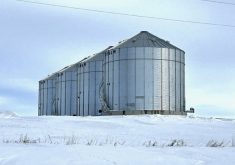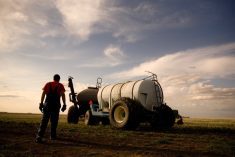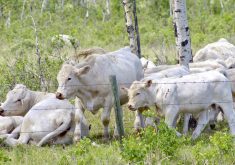Higher interest rates don’t seem to be affecting the ratio between land values and land rental costs — at least not yet.
Farm Credit Canada’s latest analysis of farmland rental prices says they’re roughly maintaining their traditional linkage, says J.P Gervais, the organization’s chief economist.
“We were curious to see whether that would bring up land rental rates faster,” says Gervais. “Not yet, it appears. Land rental rates seem to be moving roughly at the same speed as land values.”
Read Also

Seeding Indigenous agricultural prosperity
National Circle for Indigenous Agriculture and Food says Indigenous agricultural success needs strong relationships.
However, there could be a lag in the effect that interest rates have on the market.
“I think we’re going to find out,” says Gervais, adding it could take the better part of this year before it becomes apparent.
Why it matters: Understanding the rent-to-price ratio for farmland can help farmers decide whether renting land is a more viable option to free capital for other needs.
Incidentally, Gervais says that while financial markets predict a rate decrease as soon as October, he sees that as overly optimistic.
“We’ve had a pretty strong labour market, which is sustaining consumer spending. Yes, inflation is coming down, but the economy is still moving forward right now, and a lot of us thought that we would have seen a slowdown already, but we haven’t.
“The economy is more resilient than everybody expected. I think it’s a bit premature to say that we’re going to get a rate cut as soon as October. I’m starting to doubt even that’s going to happen in December.”
But Gervais says interest rates are just part of a collection of market pressures that affect rental rates.
“There are several economic conditions that impact the cost of renting land in Canada. Land values, the availability of land and its quality can all drive rental prices.”
By the numbers
In mid-April, the FCC released its annual analysis of the rent-to-price ratio for cultivated farmland in Canada. Across the country, the rent-to-price (RP) ratio in 2022 was 2.55 per cent, compared to 2.5 per cent in 2021. Most provinces saw year-over-year decreases, including Manitoba, which saw its rate drop from 2.5 per cent in 2021 to 2.4 per cent in 2022. Only Saskatchewan and Alberta had slight increases.

FCC calculates the ratio by dividing the rental cost per acre by the land value per acre. A ratio trending lower suggests that cash rental rates are appreciating at a slower pace than land values.
Around 40 per cent of Canadian farmland is rented. Typically, renting is less expensive than purchasing, and the lower the ratio, the better the renting option becomes.
For young farmers and new entrants, renting is seen as a viable option to free up capital that would otherwise be tied up in purchasing and instead can be put toward financing options for machinery or inputs.
FCC began tracking the RP ratio three years ago so it could become a tool to help farmers decide whether renting is the right option.
Another consideration, when deciding whether to buy or rent, is the relationship between rental rates and cropland revenues. Rental rates as a proportion of crop gross revenues have declined since 2020, but crop input costs have increased significantly, putting pressure on profitability.
“We know that we have lower prices than we had last year so, margins are likely to be lower,” says Gervais.
Input costs increased significantly last year but have come down a bit this year.
“I don’t think that the decline is that significant since, if you look at fertilizer prices, they’ve been trending down, but some of it has already been purchased. The bottom line is, those margins are tighter.”
Gervais warns against making snap decisions based on a partial picture. The decision to buy or rent land can have long-term implications.
“Do you have your strategic plan in mind? Where do you want to take your farm five years from now? What are the targets you have in mind?”
He says farmers will sometimes look at the price differential and interest rates and pull the trigger if their costs per acre can be reduced a little. While that’s important, it shouldn’t be the determining factor.
Gervais recommends that farmers stick to their five-year plan and only make decisions if they fit within that plan.
“If you start out looking beyond year one and have that five-year perspective, I think that opens up a bit of a different discussion and maybe different decisions, even facing the same set of numbers.
“Deciding whether to buy or rent is a strategic decision unique to each producer. There is a lot to consider, including interest rates, yields, commodity prices and input costs.”
Some limitations
Manitoba Agriculture farm management specialist Darren Bond says that looking at the RP ratio and calculating the difference in land costs based on mortgage and tax rates is useful, but it has limitations when used on its own. It doesn’t factor in things like yield and commodity prices, nor does it capture the high demand/low demand aspect of market dynamics.
“I’ve spoken to landlords over 10 miles apart who had the same productive capacity land. One was priced at $65 an acre and the other was $120 an acre,” says Bond. The difference between the two was that one was in a low-demand rental market and the other was in a hot one.
For Manitoba farmers, the province has additional tools available to help with these decisions, including a calculator on their website that considers factors like yield, commodity prices and input costs.
“It’s pretty straightforward,” says Bond.
The calculator (available in Excel form, PDF form, or as a mobile option) takes the gross revenue, subtracts the operating costs, labour costs, equipment costs, storage costs, and producer profit expectation, and calculates the maximum amount of land rent that a farmer will be able to pay.
Bond says it’s important to see the choice between renting and buying as a bottom-line decision, but many farmers have an emotional attachment to building equity in their farms.
“I always hear, ‘there’s nothing like equity,’ and ‘you don’t build equity in rented ground,’ and that’s true for sure,” he says. “But paper equity really only helps you with debt leveraging. Other than that, it doesn’t really help you.”
















